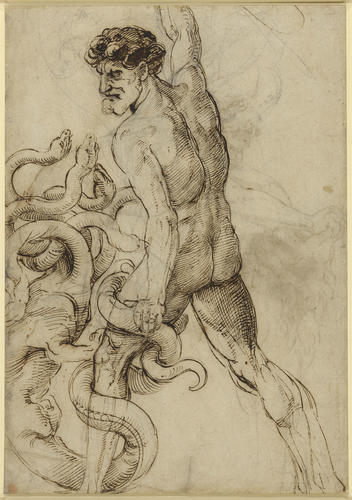-
1 of 253523 objects
Hercules and the Hydra. Verso: Hercules and the Nemean Lion c.1508
Black chalk (or charcoal?); pen and iron-gall ink | 38.9 x 27.3 cm (sheet of paper) | RCIN 912758
-
On each side of the sheet is depicted one of the Labours of Hercules: on the recto, Hercules is standing while he raises his right arm to the many-headed Hydra, on the verso, Hercules is bending to the left, fighting with a lion.
These are among a group of large and vigorous figure drawings by Raphael from the end of his Florentine period (c.1504-8). In all of these are found overdrawn contours, muscles outlined with thin strokes, and blocks of coarse hatching and cross-hatching, usually straight but occasionally hooked around the contours of the body. The unaccustomed size of these drawings suggests that Raphael was making an effort to aggrandise his style in response to the drawings of his contemporaries, especially Michelangelo, though the penwork is looser, even wilder, than anything by Michelangelo from the same period. Their weaknesses can be explained by Raphael overreaching himself and working on a scale which did not come naturally to him; this was perhaps a necessary phase in the development of such an ambitious artist.
There are several other drawings by Raphael from the same period depicting Hercules. In the British Museum is a Hercules and the Centaur (1895,0915.631); in the Ashmolean is a smaller, more carefully drawn version of the verso here (Parker 1956, no. 540), and a small sketch of Hercules and Cerberus (Parker 463),with a chequered critical history but whose attribution to Raphael is supported by comparison with his sketch in the same collection for the Segnatura Theology.
The purpose of these Hercules drawings is unknown. The large scale of the British Museum sheet and of the recto and verso here suggests that they are not merely drawing exercises with no end in mind. The bodies of Hercules and the lion are carefully placed within the perfect square of the more formal Oxford sheet, the elegant arabesque of Hercules's cloak billowing into an otherwise vacant upper corner. It would therefore appear that Raphael was thinking in compositional terms. Joannides (Michelangelo and his Influence, 1996) suggested that the Hercules drawings were possibly studies for a cycle of relief sculpture, noting that, as Michelangelo was commissioned in 1508 to carve a Hercules as a pendant to his David, Raphael's drawings may in some way reflect discussion of the project in Florence just before that date, while Michelangelo was still in Bologna.
Text adapted from M. Clayton, Raphael and his Circle, 1999, no. 14.Provenance
First recorded, without attribution, in the collection of George III, 'Inventory A', c.1810, p. 133, A large Portfolio of Drawings, no. 17, 'Hercules destroying the Hydra, on the reverse Hercules destroying the Nemean Lion, in pen and ink'.
-
Creator(s)
(artist)Acquirer(s)
-
Medium and techniques
Black chalk (or charcoal?); pen and iron-gall ink
Measurements
38.9 x 27.3 cm (sheet of paper)
Other number(s)

